Ecological Flow Response Analysis to a Typical Strong Hydrological Alteration River in China
Abstract
:1. Introduction
2. Data and Methods
2.1. Study Area
2.2. Datasets
2.3. Methods
2.3.1. Hydrological Alteration Diagnosis Approach (HADS)
2.3.2. Distributed Time-Variation Gain Model (DTVGM)
2.3.3. Probability-Weighted Flow Duration Curve (PFDC)
Frequency Analysis of Flow Series
Calculation of the Initial Monthly Ecological Flow in Different Types of Years
Calculation of Probability Weights with Copula Functions
Calculation of the Final Monthly Ecological Flow in Different Types of Years
3. Results
3.1. Hydrological Alteration Diagnosis
3.2. Runoff Restoration
3.3. Ecological Flow Calculation
4. Discussions
4.1. Hydrological Alteration Analysis of GR
4.2. Ecological Flow Model under Strong Hydrological Alteration
4.3. The Response Characteristics of Ecological Flow to a Strong Hydrological Alteration
5. Conclusions
Supplementary Materials
Author Contributions
Funding
Institutional Review Board Statement
Informed Consent Statement
Data Availability Statement
Conflicts of Interest
References
- Acreman, M.C.; Dunbar, M.J. Defining environmental river flow requirements—A review. Hydrol. Earth Syst. Sci. 2004, 8, 861–876. [Google Scholar] [CrossRef]
- Poff, N.L.R.; Matthews, J.H. Environmental flows in the Anthropocence: Past progress and future prospects. Curr. Opin. Environ. Sustain. 2013, 5, 667–675. [Google Scholar] [CrossRef]
- Cheng, B.; Li, H.; Yue, S.; Huang, K. A conceptual decision-making for the ecological base flow of rivers considering the economic value of ecosystem services of rivers in water shortage area of Northwest China. J. Hydrol. 2019, 578, 124126. [Google Scholar] [CrossRef]
- Palmer, M.; Ruhi, A. Linkages between flow regime, biota, and ecosystem processes: Implications for river restoration. Science 2019, 365, eaaw2087. [Google Scholar] [CrossRef] [Green Version]
- Milly, P.C.D.; Dunne, K.A. Colorado River flow dwindles as warming-driven loss of reflective snow energizes evaporation. Science 2020, 367, 1252–1255. [Google Scholar] [CrossRef]
- Park, S.-Y.; Sur, C.; Lee, J.-H.; Kim, J.-S. Ecological drought monitoring through fish habitat-based flow assessment in the Gam river basin of Korea. Ecol. Indic. 2019, 109, 105830. [Google Scholar] [CrossRef]
- Zhang, Q.; Xiao, M.; Liu, C.-L.; Singh, V.P. Reservoir-induced hydrological alterations and environmental flow variation in the East River, the Pearl River basin, China. Stoch. Environ. Res. Risk Assess. 2014, 28, 2119–2131. [Google Scholar] [CrossRef]
- Sabo, J.L.; Ruhi, A.; Holtgrieve, G.W.; Elliott, V.; Arias, M.E.; Ngor, P.B.; Räsänen, T.A.; Nam, S. Designing river flows to improve food security futures in the Lower Mekong Basin. Science 2017, 358, eaao1053. [Google Scholar] [CrossRef] [Green Version]
- Anker, Y.; Mirlas, V.; Gimburg, A.; Zilberbrand, M.; Nakonechny, F.; Meir, I.; Inbar, M. Effect of rapid urbanization on Mediterranean karstic mountainous drainage basins. Sustain. Cities Soc. 2019, 51, 101704. [Google Scholar] [CrossRef]
- Zhang, Q.; Gu, X.; Singh, V.P.; Chen, X. Evaluation of ecological instream flow using multiple ecological indicators with consideration of hydrological alterations. J. Hydrol. 2015, 529, 711–722. [Google Scholar] [CrossRef]
- Wang, Y.; Wang, D.; Lewis, Q.W.; Wu, J.; Huang, F. A framework to assess the cumulative impacts of dams on hydrological regime: A case study of the Yangtze River. Hydrol. Process. 2017, 31, 3045–3055. [Google Scholar] [CrossRef]
- Grill, G.; Lehner, B.; Thieme, M.; Geenen, B.; Tickner, D.; Antonelli, F.; Babu, S.; Borrelli, P.; Cheng, L.; Crochetiere, H.; et al. Mapping the world’s free-flowing rivers. Nature 2019, 569, 215–221. [Google Scholar] [CrossRef]
- Dey, P.; Mishra, A. Separating the impacts of climate change and human activities on streamflow: A review of methodologies and critical assumptions. J. Hydrol. 2017, 548, 278–290. [Google Scholar] [CrossRef]
- Fu, Y.; Leng, J.; Zhao, J.; Na, Y.; Zou, Y.; Yu, B.; Fu, G.; Wu, W. Quantitative calculation and optimized applications of ecological flow based on nature-based solutions. J. Hydrol. 2021, 598, 126216. [Google Scholar] [CrossRef]
- Tang, Y.; Chen, L.; She, Z. Evaluation of instream ecological flow with consideration of ecological responses to hydrological variations in the downstream Hongshui River Basin, China. Ecol. Indic. 2021, 130, 108104. [Google Scholar] [CrossRef]
- Tennant, D.L. Instream Flow Regimens for Fish, Wildlife, Recreation and Related Environmental Resources. Fisheries 1976, 1, 6–10. [Google Scholar] [CrossRef]
- Changming, L.; Baohui, M. An ecological hydraulic radius approach to estimate the instream ecological water requirement. Prog. Nat. Sci. 2007, 17, 320–327. [Google Scholar] [CrossRef]
- Tan, G.; Yi, R.; Chang, J.; Shu, C.; Yin, Z.; Han, S.; Feng, Z.; Lyu, Y. A new method for calculating ecological flow: Distribution flow method. AIP Adv. 2018, 8, 045118. [Google Scholar] [CrossRef]
- Long, F.; Mei, Y. Using probability-weighted FDC method to calculate basic river ecological flow. Hydrology 2017, 37, 1–5. (In Chinese) [Google Scholar]
- Wang, G.; Xiao, C.; Qi, Z.; Lai, Q.; Meng, F.; Liang, X. Research on the exploitation and utilization degree of mineral water based on ecological base flow in the Changbai Mountain basalt area, northeast China. Environ. Geochem. Health 2021, 44, 1995–2007. [Google Scholar] [CrossRef]
- Huang, S.; Chang, J.; Huang, Q.; Wang, Y.; Chen, Y. Calculation of the Instream Ecological Flow of the Wei River Based on Hydrological Variation. J. Appl. Math. 2014, 2014, 1–9. [Google Scholar] [CrossRef]
- Zhang, Q.; Zhang, Z.; Shi, P.; Singh, V.P.; Gu, X. Evaluation of ecological instream flow considering hydrological alterations in the Yellow River basin, China. Glob. Planet. Chang. 2018, 160, 61–74. [Google Scholar] [CrossRef]
- Wu, G.; Liu, Y. Assessment of the Hydro-Ecological Impacts of the Three Gorges Dam on China’s Largest Freshwater Lake. Remote Sens. 2017, 9, 1069. [Google Scholar] [CrossRef] [Green Version]
- Zhu, D.; Mei, Y.; Ben, Y.; Xu, X. Inter- and intra-annual trend analysis of water level and flow in the middle and lower reaches of the Ganjiang River, China. Hydrol. Sci. J. 2020, 65, 2128–2141. [Google Scholar] [CrossRef]
- Liu, J.; Zhang, Q.; Gu, X. Evaluation of ecological flow with considerations of hydrological alterations in the Poyang Lake basin. Acta Ecol. Sin. 2015, 35, 5477–5485. [Google Scholar]
- Gu, C.; Mu, X.; Zhao, G.; Gao, P.; Sun, W.; Yu, Q. Changes in Stream Flow and Their Relationships with Climatic Variations and Anthropogenic Activities in the Poyang Lake Basin, China. Water 2016, 8, 564. [Google Scholar] [CrossRef] [Green Version]
- Xia, S.; Liu, Y.; Wang, Y.; Chen, B.; Jia, Y.; Liu, G.; Yu, X.; Wen, L. Wintering waterbirds in a large river floodplain: Hydrological connectivity is the key for reconciling development and conservation. Sci. Total Environ. 2016, 573, 645–660. [Google Scholar] [CrossRef]
- Cheng, J.; Xu, L.; Feng, W.; Fan, H.; Jiang, J. Changes in Water Level Regimes in China’s Two Largest Freshwater Lakes: Characterization and Implication. Water 2019, 11, 917. [Google Scholar] [CrossRef] [Green Version]
- Meng, X.; Wang, H.; Chen, J. Profound Impacts of the China Meteorological Assimilation Driving Datasets for the SWAT Model (CMADS). Water 2019, 11, 832. [Google Scholar] [CrossRef] [Green Version]
- Zhao, F.; Wu, Y.; Qiu, L.; Sun, Y.; Sun, L.; Li, Q.; Niu, J.; Wang, G. Parameter uncertainty analysis of the SWAT model in a mountain-loess transitional watershed on the Chinese Loess Plateau. Water 2018, 10, 690. [Google Scholar] [CrossRef] [Green Version]
- Xie, P.; Chen, G.; Lei, H.; Wu, F. Hydrological alteration diagnosis system. J. Hydroelectr. Eng. 2010, 1, 7. (In Chinese) [Google Scholar]
- Cai, S.; Lei, X.; Meng, X.; Yi, J. Ecological flow analysis method based on the comprehensive variation diagnosis of Gini coefficient. J. Intell. Fuzzy Syst. 2018, 34, 1025–1031. [Google Scholar] [CrossRef]
- Xia, R.; Zou, L.; Zhang, Y.; Zhang, Y.; Chen, Y.; Liu, C.; Yang, Z.; Ma, S. Algal bloom prediction influenced by the Water Transfer Project in the Middle-lower Hanjiang River. Ecol. Model. 2021, 463, 109814. [Google Scholar] [CrossRef]
- Xia, J.; Wang, G.-S.; Lv, A.-F. A research on distributed time variant gain modeling. Acta Geogr. Sini-Ca-Chin. Ed. 2003, 58, 789–796. (In Chinese) [Google Scholar]
- Xia, J.; Wang, G.; Tan, G.; Ye, A.; Huang, G.H. Development of distributed time-variant gain model for nonlinear hydrological systems. Sci. China Ser. D Earth Sci. 2005, 48, 713–723. [Google Scholar] [CrossRef]
- Wang, G.; Xia, J.; Chen, J. Quantification of effects of climate variations and human activities on runoff by a monthly water balance model: A case study of the Chaobai River basin in northern China. Water Resour. Res. 2009, 45. [Google Scholar] [CrossRef] [Green Version]
- Cai, M.; Yang, S.; Zeng, H.; Zhao, C.; Wang, S. A Distributed Hydrological Model Driven by Multi-Source Spatial Data and Its Application in the Ili River Basin of Central Asia. Water Resour. Manag. 2014, 28, 2851–2866. [Google Scholar] [CrossRef]
- Duan, Q.; Sorooshian, S.; Gupta, V. Effective and efficient global optimization for conceptual rainfall-runoff models. Water Resour. Res. 1992, 28, 1015–1031. [Google Scholar] [CrossRef]
- Wang, R.; Peng, W.; Liu, X.; Jiang, C.; Wu, W.; Chen, X. Characteristics of Runoff Variations and Attribution Analysis in the Poyang Lake Basin over the Past 55 Years. Sustainability 2020, 12, 944. [Google Scholar] [CrossRef] [Green Version]
- Lei, X.; Gao, L.; Wei, J.; Ma, M.; Xu, L.; Fan, H.; Li, X.; Gao, J.; Dang, H.; Chen, X.; et al. Contributions of climate change and human activities to runoff variations in the Poyang Lake Basin of China. Phys. Chem. Earth Parts A/B/C 2021, 123, 103019. [Google Scholar] [CrossRef]
- Guo, H.; Hu, Q.; Jiang, T. Annual and seasonal streamflow responses to climate and land-cover changes in the Poyang Lake basin, China. J. Hydrol. 2008, 355, 106–122. [Google Scholar] [CrossRef]
- Ye, X.; Zhang, Q.; Liu, J.; Li, X.; Xu, C.-Y. Distinguishing the relative impacts of climate change and human activities on variation of streamflow in the Poyang Lake catchment, China. J. Hydrol. 2013, 494, 83–95. [Google Scholar] [CrossRef]


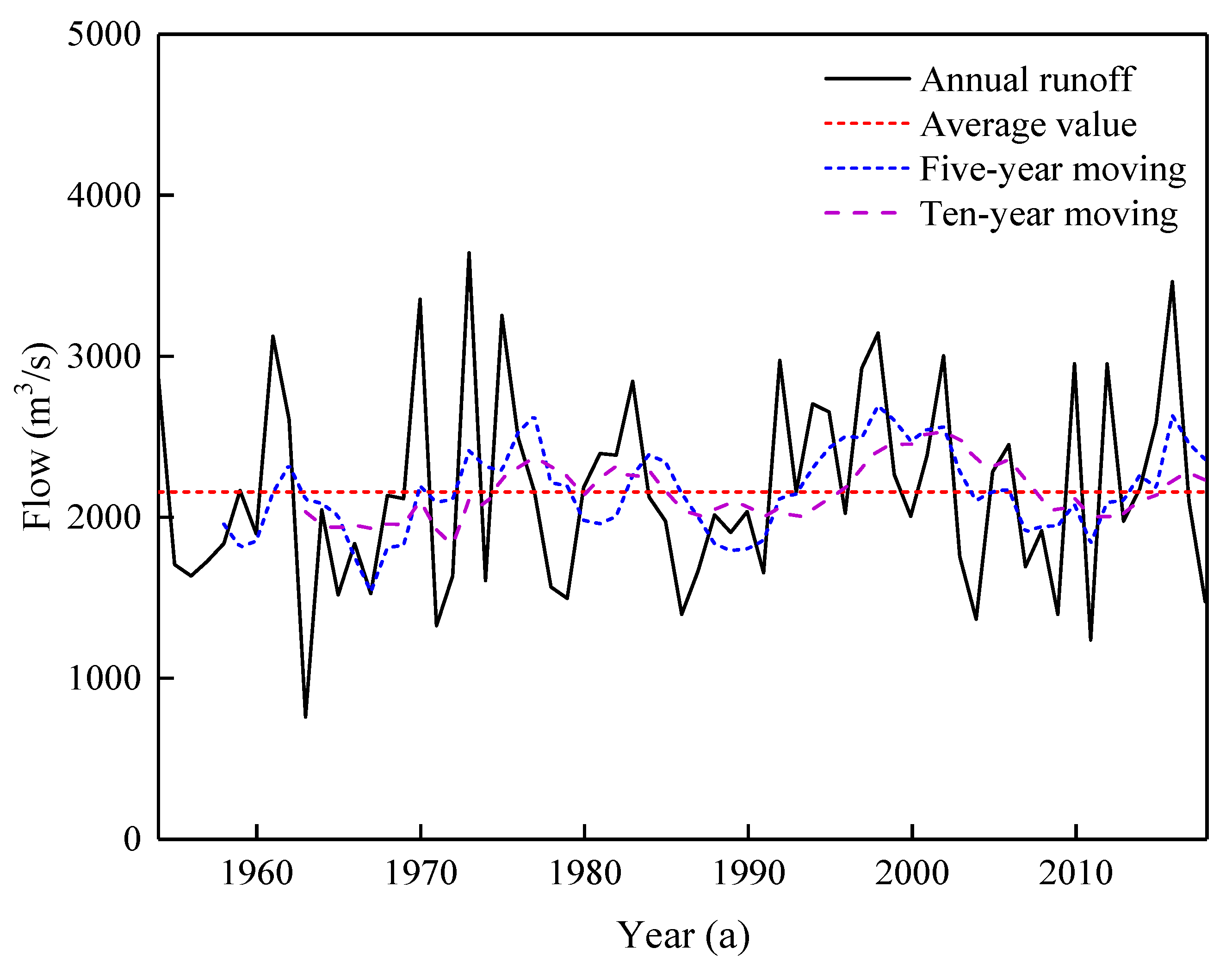
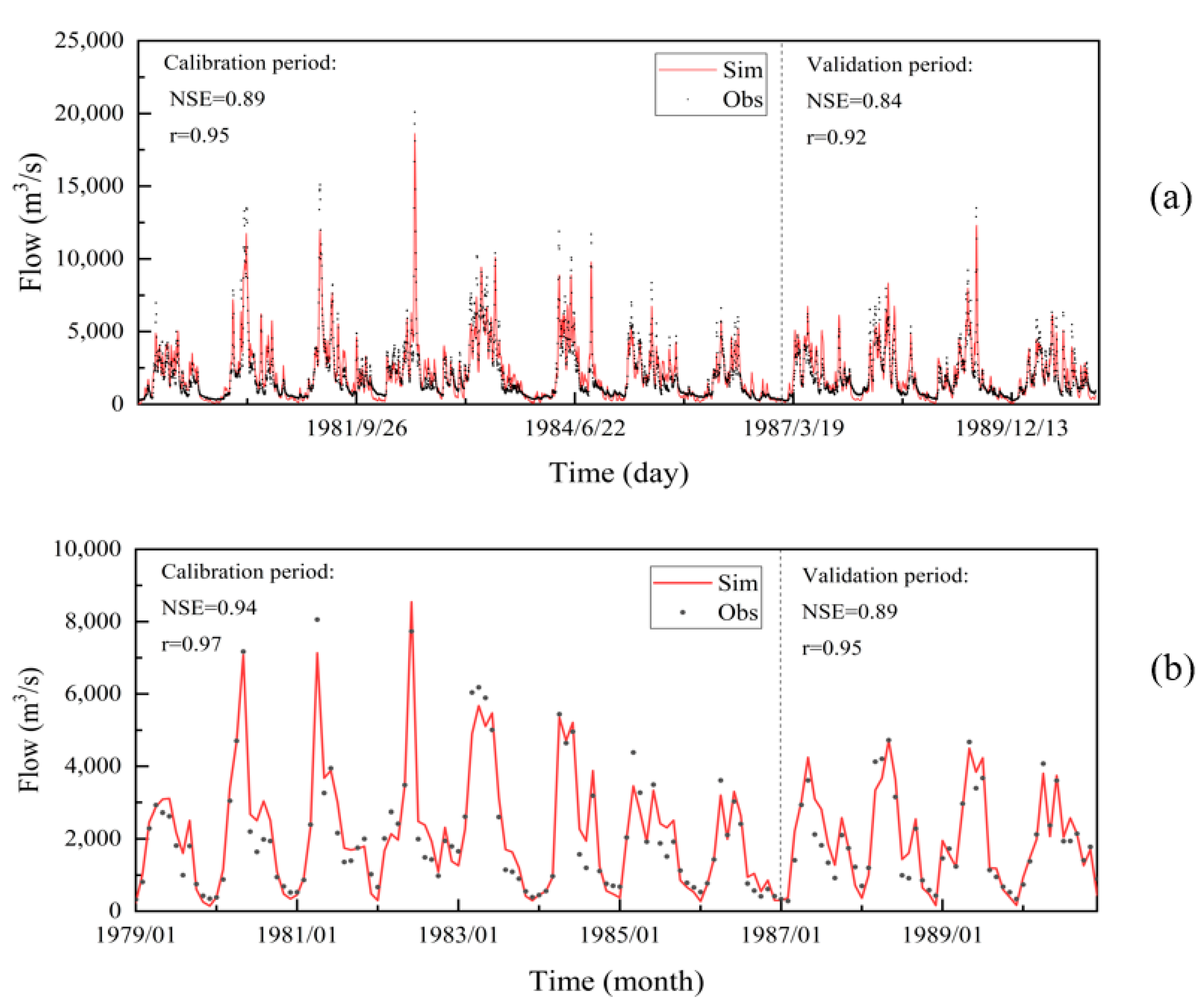

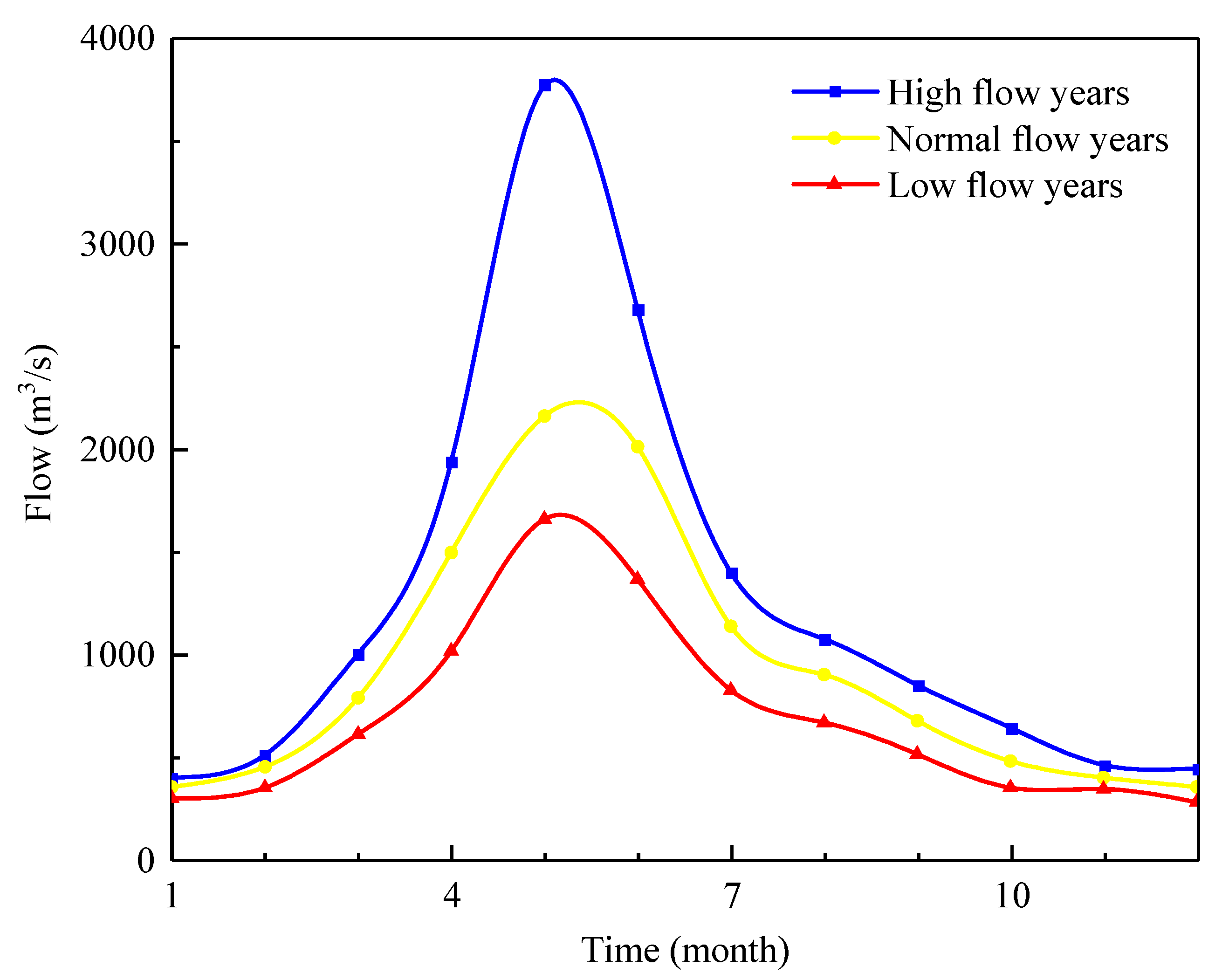
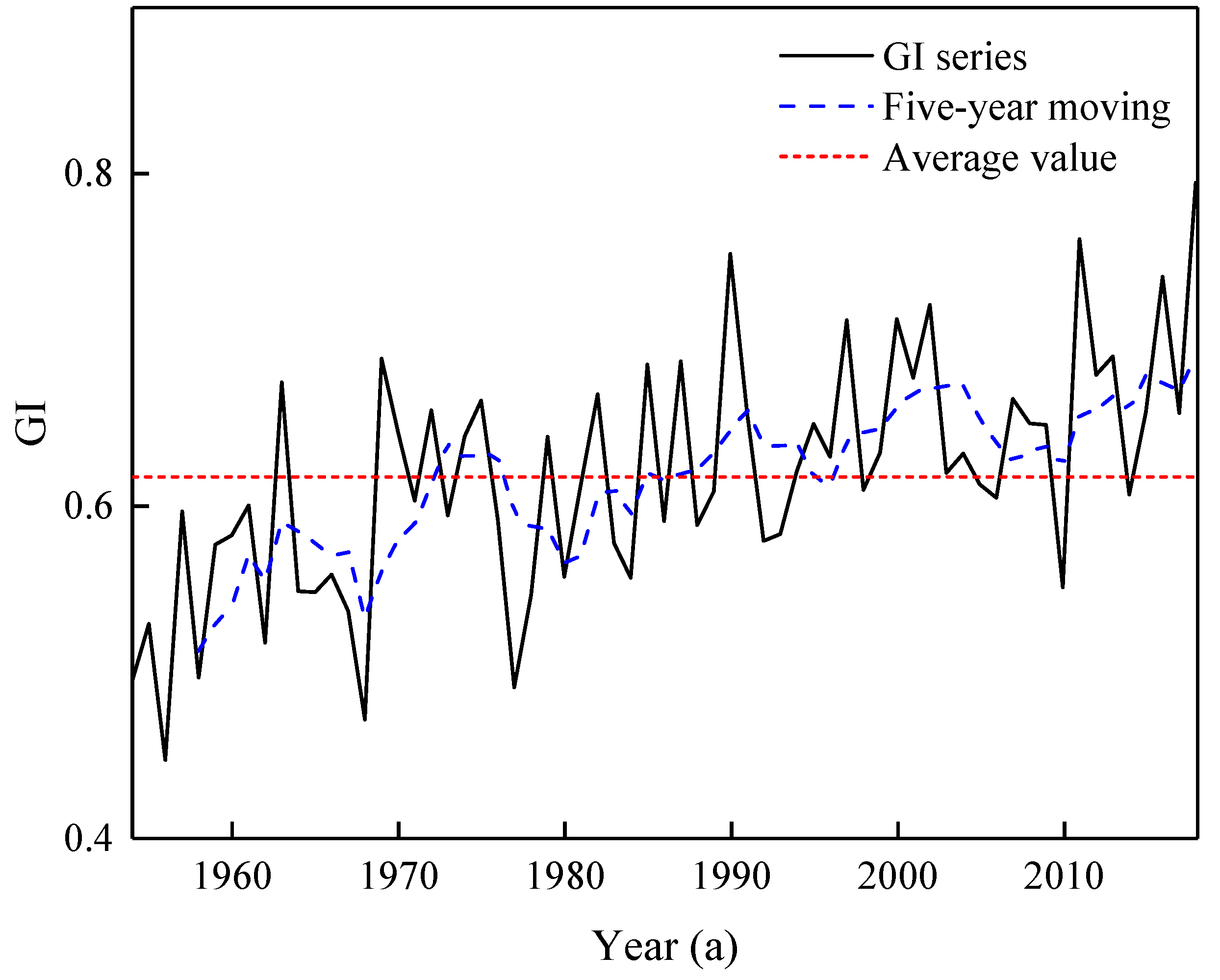
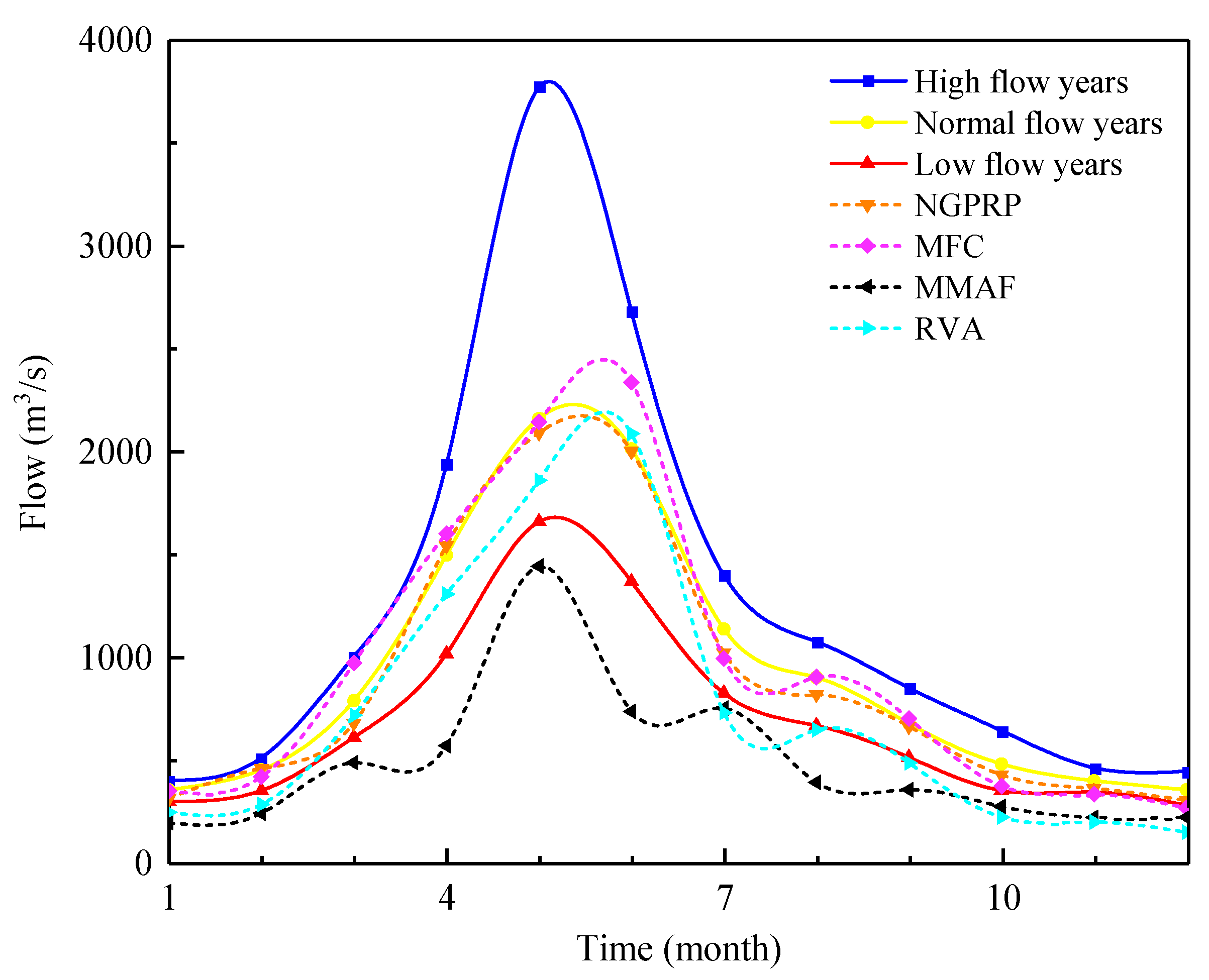
| Class | Diagnosis Method | Annual Runoff Series | Annual Rainfall Series | |
|---|---|---|---|---|
| Primary diagnosis | Hurst coeffificient | 0.7010 | 0.7074 | |
| Moving average method | Around 1990 | Around 1990 | ||
| Alteration degree | Moderate alteration | Moderate alteration | ||
| Detailed diagnosis | Trend diagnosis | Trend alteration degree | No trend alteration | No trend alteration |
| Correlation coefficient method | No trend alteration | No trend alteration | ||
| Spearman | No trend alteration | No trend alteration | ||
| Kendall | No trend alteration | No trend alteration | ||
| Jumping diagnosis | Cumulative pitch average method | 1991 | 1991 | |
| Mann–Kendall method | 1991 | 1992 | ||
| Pettitt test | 1992 | 1992 | ||
| Buishand U test | 1991 | 1991 | ||
| Mann–Whitney–Pettitt test | 1991 | 1991 | ||
| Lee–Heghinan method | 1954 | 2014 | ||
| Moving T test | 1991 | 1991 | ||
| Sliding F test | 2016 | 2016 | ||
| Ordered cluster method | 1967 | 1972 | ||
| Comprehensive diagnosis | 1991 | 1991 | ||
| Description | Value |
|---|---|
| Runoff parameter, g1 | 0.11 |
| Runoff parameter, g2 | 0.05 |
| Runoff parameter, g3 | 0.16 |
| Surface confluence parameters, Nashn | 2.92 |
| Surface confluence parameters, Nashk | 1.93 |
| Linear reservoir confluence parameters, kkg | 0.87 |
Disclaimer/Publisher’s Note: The statements, opinions and data contained in all publications are solely those of the individual author(s) and contributor(s) and not of MDPI and/or the editor(s). MDPI and/or the editor(s) disclaim responsibility for any injury to people or property resulting from any ideas, methods, instructions or products referred to in the content. |
© 2023 by the authors. Licensee MDPI, Basel, Switzerland. This article is an open access article distributed under the terms and conditions of the Creative Commons Attribution (CC BY) license (https://creativecommons.org/licenses/by/4.0/).
Share and Cite
Xia, R.; Sun, H.; Chen, Y.; Wang, Q.; Chen, X.; Hu, Q.; Wang, J. Ecological Flow Response Analysis to a Typical Strong Hydrological Alteration River in China. Int. J. Environ. Res. Public Health 2023, 20, 2609. https://doi.org/10.3390/ijerph20032609
Xia R, Sun H, Chen Y, Wang Q, Chen X, Hu Q, Wang J. Ecological Flow Response Analysis to a Typical Strong Hydrological Alteration River in China. International Journal of Environmental Research and Public Health. 2023; 20(3):2609. https://doi.org/10.3390/ijerph20032609
Chicago/Turabian StyleXia, Rui, Hao Sun, Yan Chen, Qiang Wang, Xiaofei Chen, Qiang Hu, and Jing Wang. 2023. "Ecological Flow Response Analysis to a Typical Strong Hydrological Alteration River in China" International Journal of Environmental Research and Public Health 20, no. 3: 2609. https://doi.org/10.3390/ijerph20032609




